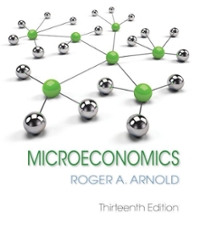Ive heard that economists build a lot of theories. Thats why I think that economics might be
Question:
I’ve heard that economists build a lot of theories. That’s why I think that economics might be too abstract a course of study. Theories come with a lot of mathematics, diagrams, and complex terms. I prefer courses that are more reality based, more practical, and more descriptive.
Hear what and how the economist thinks:
Often, when people hear the word “theory” or “model” they think mathematics and diagrams with curves; they think that anyone who deals with theory deals with something that is naturally very difficult to work with. What many people seem to not be aware of is that they work with theories all the time.
To illustrate, suppose there are two friends, Bob and Jake. Usually, Bob and Jake are extremely friendly toward each other. But one day, Jake starts acting a little differently. He seems moody, a little upset, and somewhat angry. Bob begins to wonder why Jake is acting differently than usual. Bob wonders if it has something to do with something he said the other day, if Jake is just feeling out of sorts today, or if Jake had something go wrong at work. Notice that Bob has made an observation (Jake is acting differently today); he has formulated a question based on the observation (Why is Jake acting differently today?); and he is now trying to build a theory to answer the question. But where is the math? It is nowhere to be found. Bob’s theory comes in the form of a story. One story has to do with something happening at Jake’s work. Another story has to do with something that Bob might have said earlier. In a way, a theory is really no more than a story, which a theorist believes helps to explain things.
Now consider another setting. Karen and Melissa take a college course in economics together. Until today, their economics instructor has always come to class very neatly dressed. But today he came to class looking different from his usual self: his trousers were wrinkled, he wore a wrinkled T-shirt instead of an ironed shirt, his hair wasn’t combed, and he hadn’t shaved. When the instructor enters the class, Karen turns to Melissa and asks what she thinks is up with the instructor today? Why the change in appearance?
Melissa tells a story (builds a theory). She says that she thinks the instructor got up late this morning and didn’t have time to shave or comb his hair. He just picked up the first clothes he saw—an old T-shirt and a pair of wrinkled trousers—threw them on, and rushed to class. Karen tells a different story (builds a different theory). She says that she thinks the instructor has decided to make a change in his appearance. He wants to be more casual, and not so concerned with his appearance.
Does each person’s theory come with a prediction? It does. Melissa’s theory predicts that in the next class the instructor should be back to his old ways: hair combed, shaven, ironed shirt, and unwrinkled trousers.
Karen’s theory predicts that in the next class the instructor should look the same as he does in the current class.
Theories are not something to be afraid of. And it is not just economists, chemists, biologists, and others in the sciences that build theories. Everyday people build theories all the time. True, some theories come with mathematics and diagrams, but those are simply tools that some theorists use to construct their theories, and formalize things precisely.
Questions:
1. In this text you have learned about the theory of supply and demand. There were curves drawn, equilibrium points identified, and more. State the theory of supply and demand in story form.
2. Were both Melissa’s and Karen’s theories (or predictions based on their theories)
falsifiable or refutable? Explain your answer.
Step by Step Answer:






